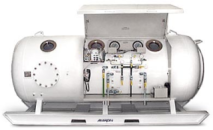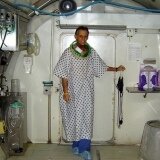Necrosis And Other Radiation Injuries as a Delayed Complications Of Radiation Exposure

Soft tissue necrosis is one of possible consequence of radiation exposure during radiotherapy, which may be defined as an ulcer located in the radiated tissue, without the presence of residual malignancy.
The occurrence of soft tissue damage is related to dose, time and volume of the radiated area.
Since ulcerations are often seen on the tumor primary site, regular evaluations are necessary until the necrosis retreats, therefore excluding the possibility of recurrence.
Besides, soft tissues may suffer fibrosis after radiotherapy, becoming pale, thin and without flexibility.
Cancer treatment has improved significantly over the past decade. Although cure of the cancer is still the highest priority of treatment, cancer specialists have come to recognize the ever-increasing importance of quality of life to the cancer survivor. One-half of the estimated 1.2 million new cases of invasive cancer will receive radiation therapy as a part of their cancer treatment.121
©2008 Undersea and Hyperbaric Medical Society, Inc. The book can be purchased at UHMS web site.
Side effects of radiation exposure can be very toxic, especially when combined with chemotherapy. Some people are more sensitive to radiation damage than others, and there are no reliable tests available as yet to identify those patients who will experience the worst radiation effects like soft tissue necrosis or bone necrosis.
Most radiation cancer specialists or oncologists design their treatment protocols to give the best dose to control the tumor and still have no more than 5% of patients develop severe reactions to treatment.
Radiotherapy has been widely used in treating malignant lesions on the head and neck, with improvement in patient survival rates. However, this therapy is still associated with several adverse reactions that affect patient quality of life significantly, and may even affect the progress of the treatment.
Taking into account that the occurrence of head and neck cancer rates are probably going to be the same as last decades, it is extremely important that health professionals are familiarized with the complications like tissue necrosis that may result from anti-neoplastic treatments.
Radiation exposure side effects are generally divided into two categories. First, there are those that happen during or just after the treatment, called acute reactions. Second, there are those that happen months or even years after the treatment, called chronic complications.
The acute side effects almost always resolve with time and are treated in such a way as to address the patients symptoms. For example, when a patient has a cancer of the mouth or throat, it becomes very difficult for the patient to eat during and just after treatment because the lining of the mouth and throat becomes raw and painful.
The cells which make up the linings of the gastrointestinal tract are sensitive to radiation. Both cancer cells and the cells that line the gastrointestinal tract have a high rate of growth, and this rapid growth rate makes them more sensitive to radiation damage. Fortunately, the normal tissue cells have excellent repair abilities and within a few weeks after the completion of radiation, this damage is repaired. In the meantime, the patient is supported with pain medicine and supplemental nutrition.
Unfortunately, chronic complications often may not get better with time and are likely to get worse. Almost all chronic radiation complications result from scarring and narrowing of the blood vessels within the area which has received the radiation treatment. If this process progresses to the point that the normal tissues are no longer receiving adequate blood supply, death or necrosis of these tissues can occur.
In the past, a severe level of necrosis would require surgical removal of the damaged tissue. This would be a devastating blow for a patient whose cancer has been cured. For example, though it occurs rarely, a patient who has had cancer of the voice box cured might require the removal of the voice box due to radiation damage. Chronic radiation damage is called osteoradionecrosis when the bone is damaged and soft tissue radionecrosis if it is muscle, skin or internal organs which have been damaged by the radiation.
Osteoradionecrosis (ORN) And Hyperbaric Oxygen Therapy (HBOT) Treatment Protocol
Osteoradionecrosis (ORN) is a bone ischemic necrosis caused by radiation, being one of the most serious consequences of radiotherapy, causing pain as well as possible substantial loss of bone structure. Due to anti-cancer therapy, bone cells and the vascularization of bone tissue may suffer irreversible injuries. ORN may occur spontaneously or more commonly, after trauma (generally dental extractions). In 95% of cases ORN is associated with soft tissue necrosis and subsequent bone exposure.
The most widely used protocol for HBOT in the prevention and treatment of osteoradionecrosis is a protocol that was initially developed by Marx and colleagues in the 1980s (the "Marx protocol"). It consists of 20 HBOT sessions prior to a surgical procedure being carried out in a previously irradiated area and 10 sessions after the procedure. Each HBOT session (sometimes referred to as a "dive") involves breathing pure oxygen at 2.4 ATA for 90 minutes.
The protocol is frequently modified in practice to suit local facilities and circumstances. Variations exist in the total number of sessions (30 - 60), pressure used (2.0 - 2.5 ATA), length of each session (60 - 120 minutes), frequency (once or twice a day), adoption of a 5-minute reprieve in every 30-minute interval for preventing oxygen toxicity and continued administration of pure oxygen during the decompression period.
Studies show that approximately 60% of patients complain of pain, ranging from mild pain, controlled with drugs, to extremely painful conditions. However, the presence of these symptoms does not appear to be related to the extension of the process. ORN may also result in edema, suppuration and pathological fractures, which may occur in 15% of patients, always experienced together with pain.
By Dirk J. Bakker, M.D.
Delayed Radiation Injuries (Soft Tissue And Bone Necrosis)
Radiation injuries should be differentiated as acute, sub-acute or delayed complications. Acute injuries are due to direct cellular toxicity caused by free radical-mediated damage to cellular DNA and are usually self-limited and treated symptomatically. However, they can be very debilitating during their duration. Sub-acute injuries are typically identifiable in only a few organ systems, e.g. radiation pneumonitis following the treatment of lung cancer with an onset typically 2 to 3 months after completion of irradiation.
These, too, are generally self-limited but occasionally evolve to become delayed injuries. Delayed radiation complications are typically seen after a latent period of six months or more and may develop many years after the radiation exposure. Often, they are precipitated by an additional tissue insult such as surgery within the radiation field.
Although the etiology of delayed injuries may vary somewhat among organ systems, the hallmark of delayed radiation injury is endarteritis with tissue hypoxia and secondary fibrosis. Recently, it has become apparent that the evolution of radiation injury is a continuum of events rather than several discrete occurrences.
The elaboration of fibrogenic cytokines begins at the time of irradiation. This recognition may permit the development of predictive assays to identify those patients at high risk for radiation injury prior to its manifestation and permit prophylactic intervention prior to its expression. Such intervention might include Hyperbaric Oxygen Therapy.
Hyperbaric oxygen (HBO2) has been utilized effectively for manifest chronic radiation injuries for many years. The site to which it has been applied for the longest period of time and with the most publications supporting its application is the mandible. The success in treating mandibular osteoradionecrosis has led researchers to apply HBO2 to radiation injuries at other sites involving other organ systems.
Hyperbaric oxygen has been shown to induce neovascularization and increased cellularity in irradiated and other hypoxic tissues. Marx and co-workers have shown in both an animal experimental model and with serial transcutaneous oxygen measurements in clinical subjects that HBO2 does increase vascular density and resultant tissue oxygen content.
Feldmeier and colleagues have shown with several assays in an animal model that tissue fibrosis can also be reduced with the application of HBO2 given in a prophylactic mode. Marx had previously established the principle of prophylactic intervention in the setting of tooth extractions and alveoloplasty from heavily irradiated mandibles. Dental extractions or other surgical procedures are fraught with high complication rates when done in heavily irradiated tissues without the benefit of preoperative HBO2therapy.121
Since the 1970s, surgeons of the head and neck region have come to recognize the value of hyperbaric oxygen treatments in treating damage of the jaw bone due to radiation. Hyperbaric oxygen has had some of its most dramatic successes in treating or preventing damage to the jaw bone as a result of radiation treatments. It has now also been applied to damage of the brain, damage of muscle and other soft tissues of the face and throat, damage to the chest wall, abdomen and pelvis as a result of radiation treatment.
Papers in medical journals also report success in treating damage to the bladder and intestines due to radiation. The high dose oxygen provided in the hyperbaric chamber is carried in the patients circulation to the site of injury to be available for repair of the damage done by the narrowing and scarring of the blood vessels. Each treatment typically takes one to two hours, and usually 30-40 daily treatments are needed for healing radiation damage resulting in soft tissue necrosis.
Share Your Story About Necrosis And Other Radiation Injuries
By telling your personal story you are helping others to learn more about soft tissue necrosis, other radiation injuries and possible treatment. Your information may be of great value for many people. Help and be helped!
If you are a doctor - get more people knowing about You and your Clinic. Please contribute by posting an article sharing your experience in healing radiation injuries like soft tissue necrosis or new clinical trials performed by your team.
What Other Visitors Have Said
Click below to see contributions from other visitors to this page...
Will Hyperbaric Oxygen Treatment Help
A Throat Cancer Complications? 


I am a 62 year old man. I was treated for throat cancer 11/99 reciving 90 grays of radiation on my left side (low jaw to just above the vocal cords) and …...
Skin And Soft Tissue Necrozis After 15 Years Of Radiotherapy Not rated yet
My mother, 79 years old, lives in Turkey had an abdominal metastaz and she took radiotherapy 15 years ago, she had skin side affects and radiotion proctit …...
Overexposed To Ionizing Radiation Caused Miscarriage.
Can Hyperbaric Oxygen Therapy Help? Not rated yet
I was exposed to ionizing radiation as a dental technician in 1980 at the age of 26. At the time I became pregnant and lost the baby. The doctor who …...












